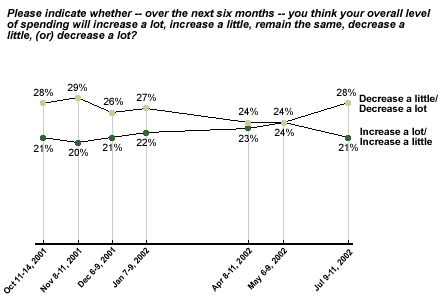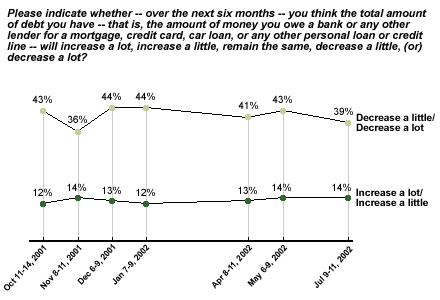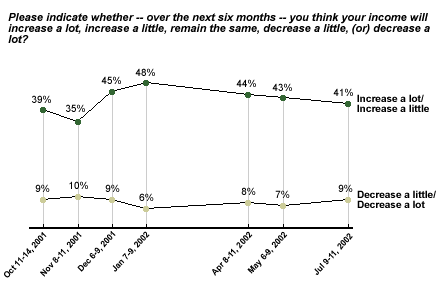New Gallup Poll economic data (July 22-24)* suggest that consumer confidence -- like investor optimism -- is weakening. Just about as many Americans now rate U.S. economic conditions as poor (24%) as say they are good or excellent (27%). This is the highest "poor" rating since 1994. Further, more than twice as many Americans (59%) say economic conditions are getting worse than say they are getting better (27%).
This downturn should not be a surprise given the way investor optimism plunged in July. Although many economists continue to argue that the economy can continue to expand while investor confidence and the stock market plummet, those of us who monitor public opinion know that is very unlikely.
The real issue is consumer spending. Will consumers continue to spend even as the markets suffer? The decline in durable goods orders and sharp decline in existing home sales in June may indicate that consumers' ability to ignore the crisis of confidence on Wall Street is weakening. More importantly (from my perspective), more consumers began telling Gallup in July that they plan to reduce their spending over the next six months than say they plan to increase it.
More Consumers Plan to Spend Less
In early July (July 9-11)**, more consumers (28%) said they plan to decrease their level of spending over the next six months than said they plan to increase it (21%). Last October, the situation was just about the same as it is now, with 28% of consumers saying they planned to spend less and only 21% saying they planned to spend more. This difference shrank during the first half of 2002 -- at 24%, the percentage of consumers saying they planned to spend more equaled the percentage saying they planned to spend less in April and May. July data show that this improved outlook for consumer spending has been completely undone.

Consumers Also Plan to Borrow Less
More consumers also plan to borrow less than plan to borrow more. In July, 39% of consumers said they plan to borrow less over the next six months while only 14% plan to borrow more. These percentages are virtually unchanged since late last year. So this situation has not gotten worse in recent months, but neither has it gotten better, which isn't good news for consumer spending.

Consumers Plan to Save More
More consumers currently plan to save more than save less. Thirty-seven percent of consumers say they plan to save more over the next six months, while only 14% plan to save less. These percentages have also been fairly consistent this year.

Still, More Consumers Expect Their Incomes to Increase
While more consumers are planning to spend and borrow less over the next six months, more also expect see their incomes increase over the same period. In the July survey, 41% of consumers said they expect their incomes to increase over the next six months, while only 9% said they expect their incomes to decrease. While the percentage of consumers expecting income increases is down from 48% in January, it is still pretty high -- particularly if the economy turns out to be weaker than expected.

Key Points
Right now, consumers' attitudes toward spending are just about where they were last August, before Sept. 11 and the sharp rally effect that followed. Before the rally effect kicked in, consumers were showing signs that they were no longer willing to continue spending as the economy weakened. I think we are looking at a similar situation in the months ahead. Unfortunately, the kinds of actions being taken to combat the current crisis of confidence are not likely to produce anything close to last year's rally effect. As a result, reduced consumer spending will mean a weaker-than-forecast U.S. economy in the months ahead.
*Results are based on telephone interviews with 1,005 national adults, aged 18 and older, conducted July 22-24, 2002. For results based on the total sample of national adults, one can say with 95% confidence that the maximum margin of sampling error is ±3%.
**Results are based on telephone interviews with 1,004 national adults, aged 18 and older, conducted July 9-11, 2002. For results based on the total sample of national adults, one can say with 95% confidence that the maximum margin of sampling error is ±3%.

